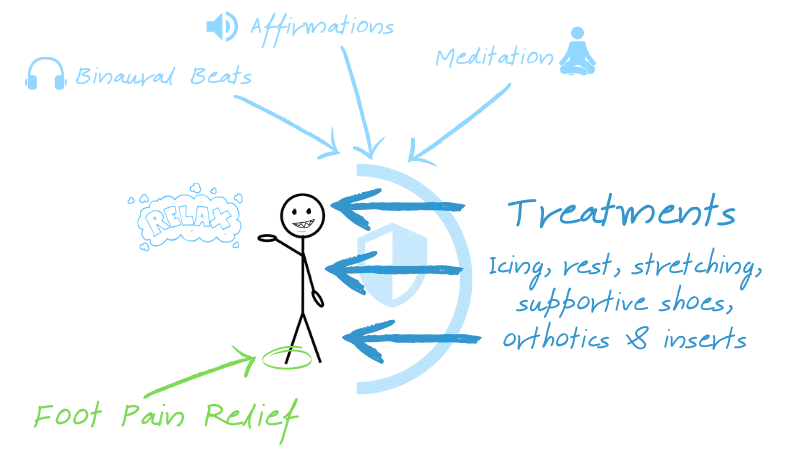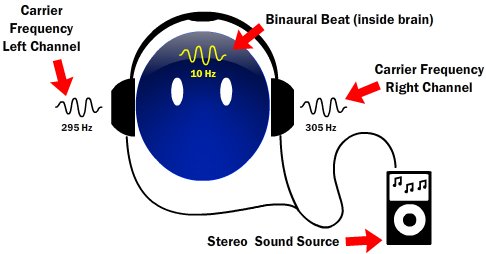Part 5: Your 30-Day Brain Action Plan
Before diving into the practical part, I want to emphasize that working on your brain requires consistency.
That’s because our brain is consists of all of our mental habits. And habits takes some time to change.
As stated earlier:
“Thoughts, emotions, and other patterns of mental activity are physical activities in the brain.“
When activity in the brain repeats itself over and over it becomes a mental habit.
And this applies to prolonged pain and stress too.
Usually, it takes a minimum of 21 days to change a mental habit.
That’s why I ask my clients to perform the daily exercise I give them for 30 days straight.
Now I’m going to show you those exact exercises.
The following three exercises are working on altering the two mechanisms (in the brain) we discussed earlier.
Good news is… that anyone can do them from home.
The three exercises are:
- Binaural Beats Therapy
- Meditation
- Affirmations
Here’s how the final goal looks like after applying them to your life:

Once the mental habits (the barrier) are removed your foot pain will start to fade rapidly until your plantar fasciitis will be gone for good.
So let’s start with the practical stuff.
Here’s your action plan for the next 30-days:
I’m going to give a brief explanation of each exercise. And then I’ll show you what, when and how you need to do.
Important Note: The following exercises are working generally towards “relaxing” or “reversing” the two (pain & stress) mechanism we learned about.
Which means it’s working also for other conditions and not only for plantar fasciitis.
Later I’ll show you how you can use them a bit different, in a more advanced way to work directly on plantar fasciitis.
(To get results ten times faster)
Another thing:
The real long-term effect of these exercises on plantar fasciitis is taking place when doing them combined.
So I recommend reading this guide till its end before taking action so you’d get the whole picture.
Let’s start:
Exercise #1: Binaural Beats Therapy
Binaural beat recordings are specially generated sounds, designed to alter brainwaves.
The basic idea behind binaural beats is that our brains operate at certain bandwidths, which are measured in frequencies.
Our brainwaves change depending on how we are feeling, and what we are doing.
Using binaural beats we can emulate natural brainwave frequencies and then slowly change them to another brainwave frequency.
When you hear two tones, one in each ear, that are slightly different in frequency, your brain processes a beat at the difference of the frequencies.
This is called a binaural beat, here’s how it looks:

Using this you can “tune” your brain for certain brainwaves that known to benefit relaxation and pain management. (Health Line)
In addition, there are a few types of brainwaves that working directly on different parts of the body.
I found one binaural beats track for foot pain that reported to have amazing results:
Start listening to it at least once a day before or while sleeping.
If you have headphones right now and you are on your computer you can even listen to this track while reading this.
Usually, it takes your brain 10-20 minutes to tune in.
Exercise #2: Meditation
When I talk about meditation people think of it as some kind of special ritual of monks and eastern gurus.
Truth is, meditation is simply relaxation and it can be done by anyone.
Today there are tons of studies about meditation and its incredible health benefits.
(Later you can read this article: Healthline – 12 Science-Based Benefits of Meditation )
According to Mayo Clinic, some research suggests that meditation may help people manage symptoms of conditions such as:
- Asthma
- Cancer
- Chronic pain
- Depression
- Heart disease
- High blood pressure
- Irritable bowel syndrome
- Sleep problems
- Tension headaches
And you can add here plantar fasciitis as well.
Now, there are many types of meditation and relaxation techniques, so which one you should choose?
You can begin with some basic guided meditation, I recommend the mobile app Headspace.
You can also use Youtube to find some other guided meditations.
Start with 10-20 minutes a day.
Soon I’ll show how you can get a meditation that targetted specifically for plantar fasciitis relief.
Exercise #3: Affirmations
I love affirmations.
Sometimes we so got used to living in pain and stress that it seems that we forgot how to enjoy life.
Affirmations, or better to say a positive affirmation, are here to break that.
In short, positive affirmations are statements that are repeated to encourage and uplift the person speaking them.
I took the definition from this article on Mindvally, great read.
In our action plan, we use affirmations as a support system for the whole treatments.
It’s simple, yet, for most people it’s life-changing.
Since we want to break the vicious cycle of our prolonged pain and stress, affirmations can be a great aid.
Positive affirmations will be your “paracetamol” in this process.
You can find a bunch of positive affirmations by searching on Google.
Like this one: Block out pain positive affirmations.
I recommend reading 10-20 affirmations twice a day.
It’s important to know that affirmations are ten times more powerful when they targeted for your specific condition.
You can look for an expert for this, to make an audio CD so you can listen throughout your day.
We actually did this, we crafted a list of specific positive affirmations for plantar fasciitis for our clients.
But more about that on the next page.
Get Results 10 Times Faster
As mentioned:
The exercises I just showed you are working generally on our pain and stress mechanism.
Over time, by performing them consistently, you’ll remove what’s blocking you from healing your plantar fasciitis.
But there’s a much faster way to achieve this.
And it’s by using these 3 exercises directly on plantar fasciitis.
Which means:
- Recorded binaural beats track specifically for plantar fasciitis
- Recorded guided meditation for plantar fasciitis
- List of affirmations for plantar fasciitis
In the next page (final part), I’m going to show you how you can get these.
